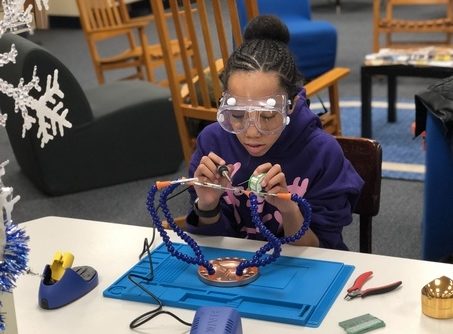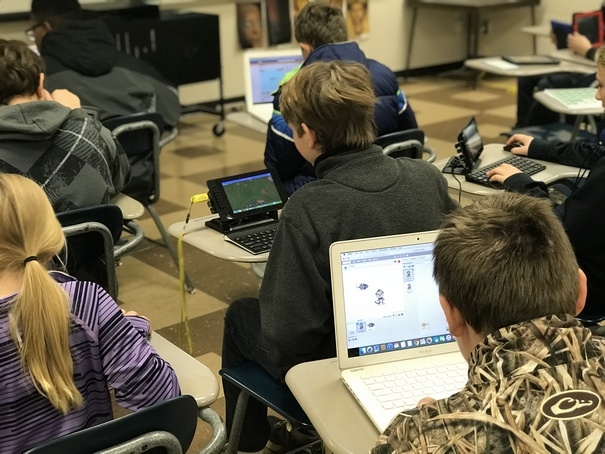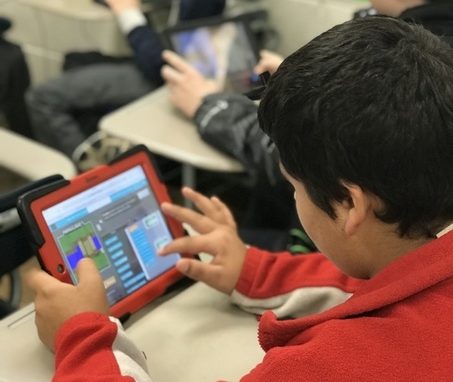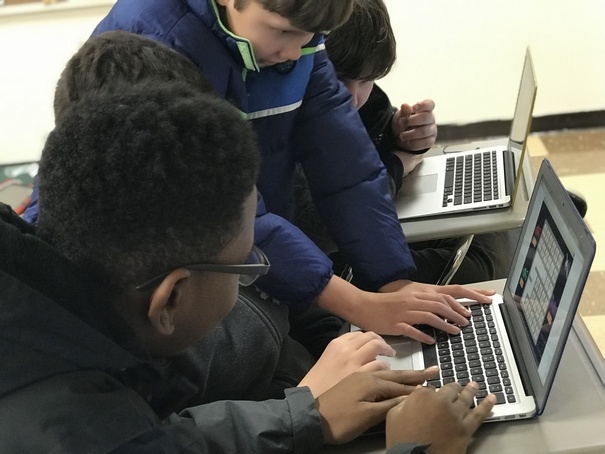
You still hear people in Kent County say “Our public schools are so awful!” Some people probably view the busing fiasco last fall or the recent, painful consolidation of elementary schools (shrinking from five to three) as further evidence of decline, even though consolidation is likely to improve educational quality. But what seems clear is that few if any of the critics have recently visited a school and observed a classroom in action, or they might have noticed that a remarkable transformation is underway.
Guided by Superintendent Dr. Karen Couch, the schools are now in the fourth year of transitioning to an entirely new educational model—one that treats each child as unique and prepares them for life and work in the 21st century far more effectively than traditional methods. The effort is positioning Kent County schools to become a leader in what is now a nationwide movement toward the use of digital learning platforms.
The old model of education is sometimes described as a teacher on one end of a log and a student on the other—or, for most of us, a teacher at the blackboard and students taking notes. In that model, it was easy for students to get bored and stop paying attention, or for slow students to get left behind. So a visit to Kent County public schools might be a bit dis-orienting at first, as if you had stumbled into a different century. Students start having “hands-on” experiences in pre-kindergarten (see video here) They are issued simplified laptops in kindergarten, start learning to “code” (write software for computers), and to understand how the internet works in 2nd grade, graduate to tablets and eventually full laptops in higher grades, and work with interactive digital tools throughout their education. Textbooks have largely disappeared—content comes in digital form, adjusted to the capabilities and needs of each individual student, and includes videos and soon virtual reality experiences that can illustrate the workings of a beating heart or how galaxies form.
Perhaps the most important aspect of the digital tools is their ability to monitor and test each student’s progress in learning in real time—making it virtually impossible for any student to just drift along. The digital platform also notices when a student has difficulty in a particular math activity or a weakness in vocabulary and can immediately reinforce the student’s learning in that area. It also keeps the teacher aware of each student’s progress, and keeps records. The digital platform supports a wide range of interactive resources—math visualizations, digital maps, competitions—that enhance learning and animate class discussions. A typical class might include a group learning activity (watching and responding to a video), an exercise conducted in a team of three or four students competing with other teams, and an individual activity where each student works alone on material appropriate to their learning level. Lesson reviews might take the form of a quiz show game, where students compete to choose the right answer. Homework assignments are on-line, and students use vetted on-line resources to research assigned topics and create and upload portfolios of their work, usually after collaborating on it with other students. A teacher can also take a class on a virtual field trip to the Grand Canyon, the Great Barrier Reef, or major art museums anywhere in the world—quite something for students who have never been off the Eastern Shore. The impact of all this on students is significant: boredom seems largely banished. Teachers report that the digital learning experience engages students like nothing they have ever seen.
What’s the Evidence that Kent County Schools are Getting Better?
 Critics of the school system point out that Kent County student scores on statewide achievement tests haven’t yet markedly improved. With a few exceptions (algebra, for example), they’re correct. But it’s also true that the school system is still in the early years of a transition to a dramatically different educational model—it will take another 8 years before graduating seniors will have used the digital platform throughout their school experience.
Critics of the school system point out that Kent County student scores on statewide achievement tests haven’t yet markedly improved. With a few exceptions (algebra, for example), they’re correct. But it’s also true that the school system is still in the early years of a transition to a dramatically different educational model—it will take another 8 years before graduating seniors will have used the digital platform throughout their school experience.
Another factor is the small size of the County’s student population—so even a few bad scores drag down the averages—combined with the unusual level of economic diversity in the county’s population. A recent statewide survey found that 40 percent of Kent County households have incomes below the ALICE (Asset Limited, Income Constrained, Employed) level—a more accurate gauge of economic constraints than federal poverty levels—which is the second highest percentage of constrained households on the Eastern Shore. In addition, Kent County receives a relatively small amount of state education aid per student—a result of the county’s relatively high amount of income and real property wealth (all those waterfront estates) and the way that is reflected in the state funding formula.
 Kent County school officials believe that tests scores will improve. They also point to the fact that teachers from outside the county, attracted by the digital platform, are increasingly applying for any vacancies—the Kent County public schools are becoming a magnet for educational talent, which will help under any educational model. Still another assessment comes from the founder of LearnLaunch in Boston—the country’s leading “Ed-Tech” accelerator—who told this reporter that “the Kent County schools are clearly among the top 10% of districts in the US in their adoption and use of these new educational tools.” In fact, Kent County is the lead county in Maryland in the use of a digital educational platform; Baltimore County has recently decided to begin a similar transition. Furthermore, the County’s recent acquisition of its own fiber network and its plans to ensure near-universal internet access to households with students means that students can take advantage of the digital platform and its growing universe of content evenings and weekends too.
Kent County school officials believe that tests scores will improve. They also point to the fact that teachers from outside the county, attracted by the digital platform, are increasingly applying for any vacancies—the Kent County public schools are becoming a magnet for educational talent, which will help under any educational model. Still another assessment comes from the founder of LearnLaunch in Boston—the country’s leading “Ed-Tech” accelerator—who told this reporter that “the Kent County schools are clearly among the top 10% of districts in the US in their adoption and use of these new educational tools.” In fact, Kent County is the lead county in Maryland in the use of a digital educational platform; Baltimore County has recently decided to begin a similar transition. Furthermore, the County’s recent acquisition of its own fiber network and its plans to ensure near-universal internet access to households with students means that students can take advantage of the digital platform and its growing universe of content evenings and weekends too.
But both administrators and teachers in the school system say that the best—and for now, the only way—to really gauge the difference is to see the new educational model in action: to sit in a classroom and watch how students are engaged in learning. Many parents, wondering if and how this new educational model really works and what their child does all day, would probably like to do just that—but don’t have the opportunity. So this reporter has visited and observed three classrooms in action—3rd grade math, 6th grade science, and 12th grade Advanced Placement psychology—and will in a second article offer his observations, together with videos of classrooms in action.
*************************
But beyond the technology, what is really going on is an educational process that is far more student-centered than anything most adults have experienced. In an advanced math lesson, each student proceeds at their own pace, checking that they have understood a concept before moving on to the next material. The teacher, freed from lecturing, can monitor each student’s progress and intervene when a student seems stuck. Imagine a 3rd grade class doing a social studies lesson, all reading the same material, but with the vocabulary adjusted to fit the reading level of each individual student—which in Kent County can mean, as one teacher explained, “some kids who can barely read and others reading at 8th-grade level, but all able to engage and discuss the lesson together.” The technology, in effect, helps bridge learning gaps, so slower students are neither left behind nor slow down the entire class. The technology also allows the teacher to respond to different areas of interest within a class—“six different videos going at once, or the ability to project a student’s just-submitted portfolio onto the screen so the whole class can discuss it.” One teacher said “I was dubious and a bit intimidated at first. Now I wouldn’t want to teach without my tablet and the digital platform—it makes things so much easier, and the kids learn better.”
How did this come about? It began with the recruitment of a visionary educator—Dr. Couch—who had begun to use digital tools in her previous assignment and had seen their impact. When she arrived in Kent County, the Governor’s office was offering an educational innovation grant—large enough to finance the equipment, software tools, and services needed to start a digital makeoverhere. So Dr. Couch and her team applied and won. The transformation has also involved strong support from the School Board and the County Commissioners, who have supported Dr. Couch’s plans with additional budget.
A second factor depended on engaging and empowering teachers. Dr. Couch recruited 22 teachers who were interested in the new educational model and willing to become part of a “digital leader corps” to be trained as the initial users of the digital platform. It involved a three-year commitment by those teachers, with 15 days of off-site training as well as near constant mentoring by phone and email from an expert coach. Some of that initial corps were understandably a bit uncertain whether the extra effort would be worth it. Within a year, however, the doubts disappeared: the teacher corps has become both advocates of the digital tools and a resource for other teachers, helping to spread expertise through the system. Teachers especially appreciate the intensive coaching, and say that even on a Sunday evening, struggling to prepare digital materials for class the next day, they could email their coach and get immediate help. A new corps—eight more teachers—entered the training process this school year. In two more years, when the current corps finishes their training, the majority of the district’s teachers will be highly skilled in the use of the digital platform and its interactive tools.
A third factor is the rise of what is now called the Ed Tech revolution—hundreds of companies developing digital tools and content that facilitate improved, individualized learning. One of the leaders in this new industry—and the source of the primary digital content for Kent County schools—is Discovery Education. Created in 2009 as a division of the Discovery Channel, the company began by selling classroom videotapes drawn from their successful nature and science cable channel. But they soon realized that kids interact with digital content in a different way than they do with books or simple video tapes. So they began to create a digital platform for schools and a unique kind of digital content: for social studies classes, material with vocabulary that could be adjusted to a child’s current reading level; for science and math classes, interactive content that kids found more engaging and helped them to visualize or understand concepts better. The result is what are now digital “textbooks” spanning a wide range of content for k-12 classes and designed to enable students to learn in the way that suits them best. The Discovery educational materials can even read themselves out loud for students who can’t yet read, or provide content in another language such as Spanish for students still learning English. The Kent County digital educational platform also includes Google’s educational apps that include unlimited digital storage, Google Expeditions (the virtual fieldtrips), Google Cardboard (virtual reality tools), and Google Classroom, which tracks kids’ progress and handles administrative records for teachers, enabling almost paperless schools.
 Discovery Education also provides the intensive off-site training for teachers as well as the coaches that help teachers with day-to-day use of the materials and tools. Teachers seem to love the tutorial sessions and they say that the company introduces them to a wide range of available tools (many new ones crop up every year), not just those made by Discovery Education. As a result, Discovery Education has become a clear leader in fostering the digital transformation of education—their content is now used in half of the k-12 classrooms in the U.S. and by some 50 million students overseas in more than 50 other countries. Tens of thousands of teachers across the U.S. are using these tools to prepare digital lesson plans, sharing them with each other online, and rating their effectiveness. Teachers in Kent County usually create their own digital lesson plans, but they can also—and do—choose from the best of those already on-line.
Discovery Education also provides the intensive off-site training for teachers as well as the coaches that help teachers with day-to-day use of the materials and tools. Teachers seem to love the tutorial sessions and they say that the company introduces them to a wide range of available tools (many new ones crop up every year), not just those made by Discovery Education. As a result, Discovery Education has become a clear leader in fostering the digital transformation of education—their content is now used in half of the k-12 classrooms in the U.S. and by some 50 million students overseas in more than 50 other countries. Tens of thousands of teachers across the U.S. are using these tools to prepare digital lesson plans, sharing them with each other online, and rating their effectiveness. Teachers in Kent County usually create their own digital lesson plans, but they can also—and do—choose from the best of those already on-line.
The aim of Kent County public school’s new education model is not only to teach traditional subjects—English, math, science, social studies—more effectively, but also to teach critical skills that will be needed in the 21st century workforce. These include skills in teamwork and collaboration, as well as the technical ability to use and program smart digital devices and interactive digital content (See Box below: Hands-On Training in IT Skills) and the intellectual ability to evaluate ideas and content critically. Such skills –both the teamwork and critical thinking skills, as well as the technical skills—are likely to become more and more essential for getting and keeping a job, especially as robots and artificial intelligence invades the workplace. For that reason, there is now a renewed focus on teaching such skills across the U.S. as well as internationally. In Maryland alone there are currently more than 100,000 unfilled positions in such areas as cybersecurity, computer system maintenance, or IT application development. So Kent County’s 21st century approach to education is clearly going to be advantageous for the students, as well as for local businesses.
But the stakes go beyond equipping today’s students. Already the most valuable U.S. companies are so-called “platform businesses” that build and maintain vast IT-based networks connecting billions of users—think Google, Facebook, Amazon, Apple, Uber. These companies are very profitable, highly efficient, and increasingly global in their reach. Many business analysts now believe that such companies will dominate nearly every sector of the economy. Although the U.S. now leads in digital education and Ed-Tech tool development, China is accelerating its investment in these areas as well, and it too has platform businesses with global ambitions. So training an IT-savvy workforce is likely to be important for the future of U.S. economic competitiveness.
For Kent County, with its coming new high-speed internet infrastructure and a new industrial park in progress that hopes to attract sophisticated businesses and new residents, a high-quality public school system attuned to the skills that today’s job market increasingly needs is an essential requirement. Fortunately, that seems well on the way to becoming a reality.
**************************************************************
Hands On Training in IT Skills
 Kent County public schools are unique in expecting students to complete both a college-prep curriculum and a Career Technical Training (CTE) curriculum focused on practical skills, which more than 80 percent of students complete. Now the latter is being expanded to include information technologies. The schools already teach coding (programming digital devices) because, as Dr. Laura Jacob—the new head of technology for the school system—says, “programming is the next literacy.” Dr. Jacob has only been here since the summer, but already she serves on a committee that is establishing Maryland K-12 computer science standards. She also applied for and won a Google grant for Kent County (the only Maryland school district to win one) that is enabling 6th – 8th graders to learn more advanced programming and app development in bi-weekly after-school sessions. The students then work with local businesses to put those skills to practical use—micro-coding the controls for a fan at Dixon Valve was one of the first projects. A comparable program for high school students will focus on “ethical hacking”, helping organizations test their on-line security systems. These will be part of a new K-12 digital skills CTE curriculum that Jacob is organizing and that will culminate with an Advanced Placement computer science course for high school seniors.
Kent County public schools are unique in expecting students to complete both a college-prep curriculum and a Career Technical Training (CTE) curriculum focused on practical skills, which more than 80 percent of students complete. Now the latter is being expanded to include information technologies. The schools already teach coding (programming digital devices) because, as Dr. Laura Jacob—the new head of technology for the school system—says, “programming is the next literacy.” Dr. Jacob has only been here since the summer, but already she serves on a committee that is establishing Maryland K-12 computer science standards. She also applied for and won a Google grant for Kent County (the only Maryland school district to win one) that is enabling 6th – 8th graders to learn more advanced programming and app development in bi-weekly after-school sessions. The students then work with local businesses to put those skills to practical use—micro-coding the controls for a fan at Dixon Valve was one of the first projects. A comparable program for high school students will focus on “ethical hacking”, helping organizations test their on-line security systems. These will be part of a new K-12 digital skills CTE curriculum that Jacob is organizing and that will culminate with an Advanced Placement computer science course for high school seniors.
**************************************************************
Photography by Laura Jacob



Jim Bogden says
Very informative article! Thank you for the in-depth look into our schools.
Frances Miller says
Fascinating! Thanks for giving us this amazing glimpse into the future of education. Can’t think of a better investment for my taxes than the Kent County Schools and the dedicated people who are equipping our children to deal with a future their grandparents find hard to imagine.
Rachel Perry says
Nice article. It is great to see how the partnership with Discovery Channel has provided resources to help build on previous initiatives to bring tech to our schools with help from 21st Century state grants. Progress is being made. My oldest was lucky enough in her senior year last year to get her first taste of computer science through the new AP course introduced. That was enough to convince her (and others) to pursue a path in CS in college. I am thrilled that the county can now start introducing coding even to our elementary school students, giving them some of the advantages available to larger, more affluent school districts.
As a KCPS parent since 2005, it has felt to me as if our school system has been fighting an uphill PR battle the entire time we have been a part of it. And though I have never proclaimed it to be perfect or without its drawbacks, I have been impressed with how teachers, administrators, and parents who are motivated can communicate and come together to make the most of limited resources. Being small does have some advantages. It can be a bit more nimble as far as trying new initiatives (like Discovery Channel), but also getting involved can really make a difference-as a parent, as a student, and as a community member. Personally, our family has benefitted from community involvement in our schools in numerous ways-from Dixon Valve helping with everything from STEM to writing skills, to individuals like Zane Carter volunteering to help with Science Olympiad, to our local art community helping with Reflections art contests and supporting the Arts In Motion initiative. Especially with the current financial challenges that our schools face, let us not forget the impact that parent and community involvement can make.
Robert Kramer says
assessment comes from the founder of LearnLaunch in Boston—the country’s leading “Ed-Tech” accelerator—who told this reporter that “the Kent County schools are clearly among the top 10% of districts in the US in their adoption and use of these new educational tools.” >>>>
Let this sink in. Mr Hammond gives an up close and personal assessment of our public school system. We’re going to cheer because we are, after all, a little biased. The investment of time, energy and technology is paying off for our most important asset… our kids. The time is coming very soon and may actually be upon us that we have to decide how much is it worth to us as a community to maintain a superior small rural school system. And it all starts with attracting, hiring and maintaining teachers. And this costs money. Let this sink in.
Martha Ross says
Article very informative, very proud my granddaughter is a teacher at KCMS. Kent County is lucky to have many dedicated teachers and educators in its school system.